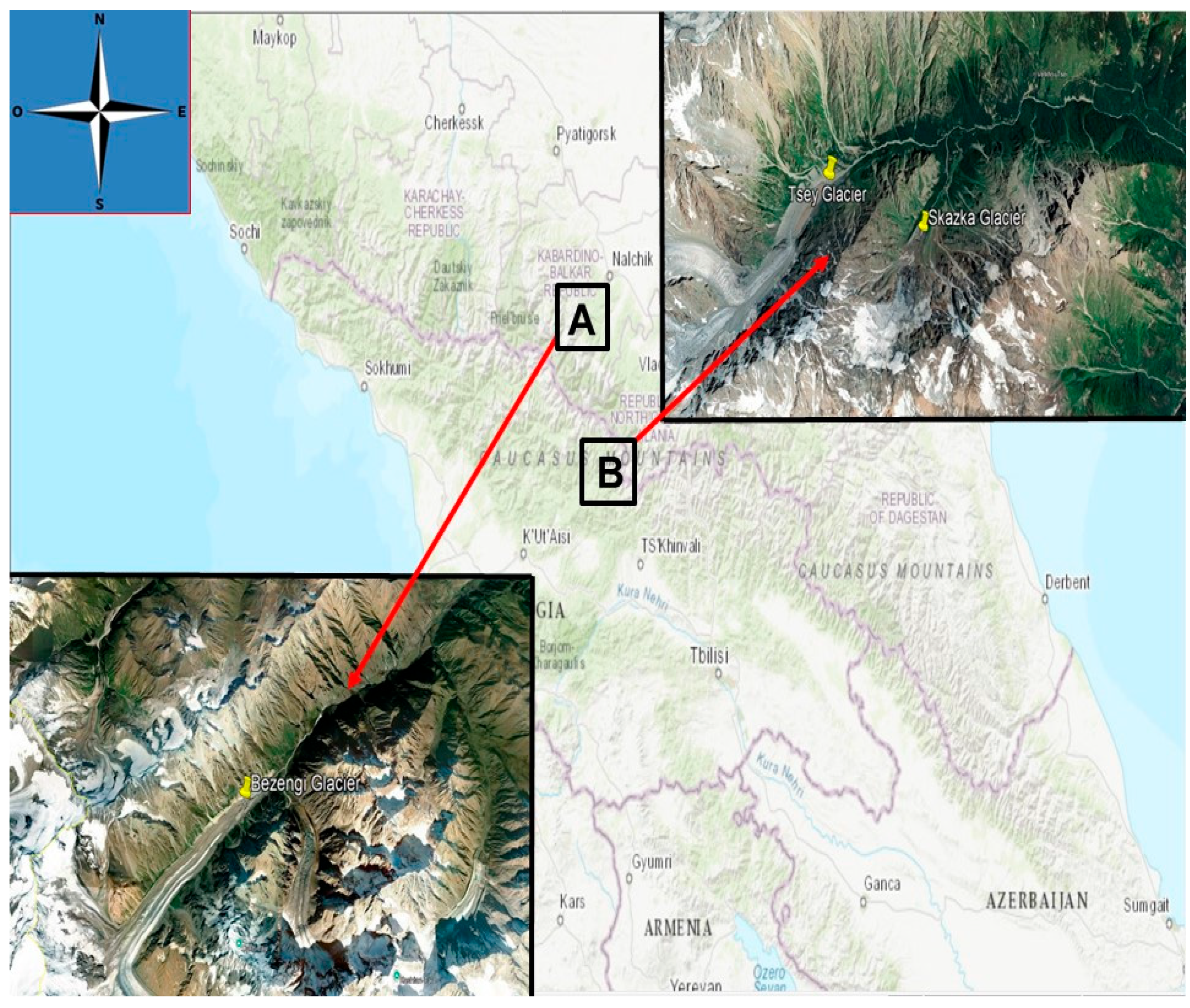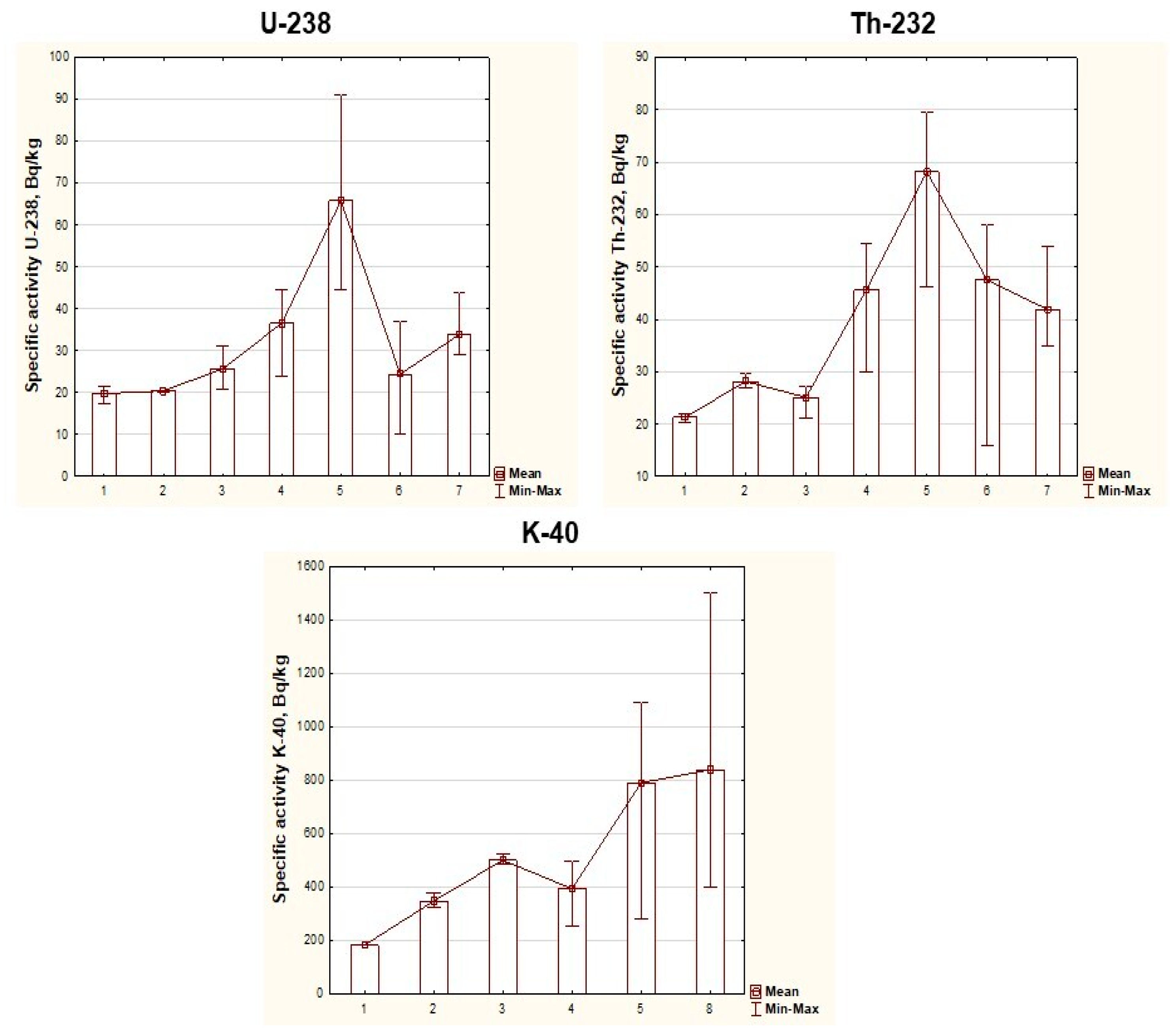Specific Activity of Radionuclides in Cryoconite Sediments of Glaciers of the Central Caucasus (Tsey, Skazka, Bezengi), Russia
Abstract
1. Introduction
2. Materials and Methods
2.1. Study Areas
2.2. Sampling Strategy
2.3. Gamma Spectrometry
2.4. Statistical Processing of Data
3. Results and Discussions
3.1. Specific Activity of Natural Radionuclides in Cryoconites
3.2. Specific Activity of Anthropogenic Radionuclide Cs-137 in Cryoconites
4. Conclusions
Author Contributions
Funding
Institutional Review Board Statement
Informed Consent Statement
Data Availability Statement
Acknowledgments
Conflicts of Interest
References
- Lastovkin, V. Fundamentals of Radiation Safety; Publishing House NNGASU: Nizhny Novgorod, Russia, 2017; p. 143. (In Russian) [Google Scholar]
- Buraeva, E. Radioactivity of Soils in the South of the European Part of Russia. Doctoral Dissertation in Biological Sciences, Southern Federal University, Rostov-on-Don, Russia, 2023; p. 466. (In Russian). [Google Scholar]
- UNSCEAR. Sources and Effects of Ionizing Radiation, Vol. 1; United Nations Scientific Committee on the Effects of Atomic Radiation: New York, NY, USA, 2000; p. 245. [Google Scholar]
- Ojovan, M.; Lee, W.; Kalmykov, S. Introduction to Immobilisation. In An Introduction to Nuclear Waste Immobilisation; Elsevier Science BV: Amsterdam, The Netherlands, 2019; pp. 1–7. [Google Scholar]
- Nikanorov, A.; Khoruzhaya, T. Global Ecology: Textbook; Prior Publishing House: Moscow, Russia, 2001; p. 284. (In Russian) [Google Scholar]
- Karlsson, L.; Hernandez, F.; Rodríguez, S.; López-Pérez, M.; Hernandez-Armas, J.; Alonso-Pérez, S.; Cuevas, E. Using 137Cs and 40K to identify natural Saharan dust contributions to PM10 concentrations and air quality impairment in the Canary Islands. Atmos. Environ. 2008, 42, 7034–7042. [Google Scholar] [CrossRef]
- Delmotte, V.; Zhai, P.; Pirani, A.; Connors, S.; Péan, C.; Berger, S.; Caud, N.; Chen, Y.; Goldfarb, L.; Gomis, M.; et al. Climate Change 2021: The Physical Science Basis. Contribution of Working Group I to the Sixth Assessment Report of the Intergovernmental Panel on Climate Change; Cambridge University Press: Cambridge, UK, 2021; 2391p. [Google Scholar]
- Milillo, P.; Rignot, E.; Rizzoli, P.; Scheuchl, B.; Mouginot, J.; Bueso-Bello, J.L.; Prats-Iraola, P.; Dini, L. Rapid glacier retreat rates observed in West Antarctica. Nat. Geos. 2022, 15, 48–53. [Google Scholar] [CrossRef]
- Geyman, E.; van Pelt, W.J.; Maloof, A.; Aas, H.; Kohler, J. Historical glacier change on Svalbard predicts doubling of mass loss by 2100. Nature 2022, 601, 374–379. [Google Scholar] [CrossRef] [PubMed]
- Wang, Z.; Zhang, F.; Li, X.; Xing, M.; Cao, Y.; Wang, H.; Hu, J.; Lu, H.; Dong, J.; Liu, H.; et al. A substantial meltwater event on the northeastern Tibetan Plateau during the middle to late Holocene transition. Quat. Sci. Rev. 2024, 344, 108996. [Google Scholar] [CrossRef]
- Reinthaler, J.; Paul, F. Reconstructed glacier area and volume changes in the European Alps since the Little Ice Age. Cryosphere 2025, 19, 753–767. [Google Scholar] [CrossRef]
- Kotlyakov, V.; Khromova, T.; Nosenko, G.; Muravyov, A.; Nikitin, S. Glaciers in the mountains of Russia (Caucasus, Altai, Kamchatka) in the first quarter of the 21st century. Ice Snow 2023, 63, 157–173. (In Russian) [Google Scholar] [CrossRef]
- Ferrario, C.; Pittino, F.; Tagliaferri, I.; Gandolfi, I.; Bestetti, G.; Azzoni, R.; Diolaiuti, G.; Franzetti, A.; Ambrosini, R.; Villa, S. Bacteria contribute to pesticide degradation in cryoconite holes in an Alpine glacier. Environ. Pollut. 2017, 230, 919–926. [Google Scholar] [CrossRef]
- Lyu, X.; Cui, W.; Ji, M.; Wang, W.; Zhang, Z.; Liu, Y. The distribution and drivers of microbial pigments in the cryoconite of four Tibetan glaciers. Environ. Microbiol. 2024, 26, e16550. [Google Scholar] [CrossRef]
- Wejnerowski, Ł.; Poniecka, E.; Buda, J.; Klimaszyk, P.; Piasecka, A.; Dziuba, M.; Mugnai, G.; Takeuchi, N.; Zawierucha, K. Empirical testing of cryoconite granulation: Role of cyanobacteria in the formation of key biogenic structure darkening glaciers in polar regions. J. Phycol. 2023, 59, 939–949. [Google Scholar] [CrossRef]
- Łokas, E.; Zaborska, A.; Sobota, I.; Gaca, P.; Milton, J.; Kocurek, P.; Cwanek, A. Airborne radionuclides and heavy metals in high Arctic terrestrial environment as the indicators of sources and transfers of contamination. Cryosphere 2019, 13, 2075–2086. [Google Scholar] [CrossRef]
- Baccolo, G.; Łokas, E.; Gaca, P.; Massabò, D.; Ambrosini, R.; Azzoni, R.; Clason, C.; Di Mauro, B.; Franzetti, A.; Nastasi, M.; et al. Cryoconite: An efficient accumulator of radioactive fallout in glacial environments. Cryosphere 2020, 14, 657–672. [Google Scholar] [CrossRef]
- Owens, P.; Blake, W.; Millward, G. Extreme levels of fallout radionuclides and other contaminants in glacial sediment (cryoconite) and implications for downstream aquatic ecosystems. Sci. Rep. 2019, 9, 12531. [Google Scholar] [CrossRef] [PubMed]
- Kushnov, I.; Abakumov, E.; Polyakov, V.; Tembotov, R. Geochemistry of cryoconite and soils in the Central Caucasus region and its environmental implications. J. Mt. Sci. 2021, 18, 3109–3124. [Google Scholar] [CrossRef]
- Abakumov, E.; Tembotov, R.; Polyakov, V.; Ivanov, M.; Mavlyudov, B.; Kushnov, I.; Nizamutdinov, T.; Yaneva, R.; Zhiyanski, M. Concentration of trace elements in cryoconites of mountain and polar regions of the World. Geosciences 2023, 13, 188. [Google Scholar] [CrossRef]
- Abakumov, E.; Gangapshev, A.; Gezhaev, A.; Tembotov, R. Radionuclide activity in cryoconite from glaciers of the Central Caucasus, Russia. Solid Earth Sci. 2022, 7, 268–275. [Google Scholar] [CrossRef]
- Tembotov, R.; Gangapshev, A.; Gezhaev, A.; Abakumov, E. Assessment of radioactivity of cryoconites from glaciers of Elbrus mountain and glacial soils of Elbrus region, Russia. Int. J. Environ. Sci. Technol. 2024, 2024, 1–12. [Google Scholar] [CrossRef]
- Tielidze, L.; Wheate, R. The Greater Caucasus Glacier Inventory (Russia, Georgia and Azerbaijan). Cryosphere 2018, 12, 81–94. [Google Scholar] [CrossRef]
- Makarova, O.; Antipova, M.; Babenko, A.; Bushueva, I.; Chulei, A.; Golovatch, S.; Doroshina, G.; Kolesnikov, V.; Mazei, Y.; Makarov, K.; et al. Successions of terrestrial invertebrate communities during the Tsey Glacier retreat, Central Caucasus. Caucasiana 2024, 3, 41–87. [Google Scholar] [CrossRef]
- Bushueva, I. Fluctuations of Glaciers in the Central and Western Caucasus According to Cartographic, Historical and Bioindication Data over the Past 200 Years. Candidate of Geographical Sciences Dissertation, Institute of Geography RAS, Moscow, Russia, 2013; p. 169. (In Russian). [Google Scholar]
- Adzhiev, A.; Shevchenko, A.; Kondratyeva, N.; Yurchenko, N. Degradation of glaciation in the Greater Caucasus under the influence of climate change. Adv. Mod Sci. 2022, 6, 27–34. (In Russian) [Google Scholar]
- Barba-Lobo, A.; San Miguel, E.; Lozano, R.; Bolívar, J. A general methodology to determine natural radionuclides by well-type HPGe detectors. Measurement 2021, 181, 109561. [Google Scholar] [CrossRef]
- Kocak, I.; Eke, C.; Buyuk, B.; Kamislioglu, M.; Ozkara, O. Determination of natural radioactivity level of boron waste deposits in Bandirma, Balikesir, Turkey. Int. J. Environ. Sci. Technol. 2023, 21, 845–856. [Google Scholar] [CrossRef]
- Baccolo, G.; Di Mauro, B.; Massabo, D.; Clemenza, M.; Nastasi, M.; Delmonte, B.; Prata, M.; Prati, P.; Previtali, E.; Maggi, V. Cryoconite as a temporary sink for anthropogenic species stored in glaciers. Sci. Rep. 2017, 7, 9623. [Google Scholar] [CrossRef] [PubMed]
- Adjei, D.; Trinh, N.; Mostafavi, M. Application of Geant4-DNA for simulating water radiolysis induced by Auger electron-emitting radionuclides. J. Radiat. Res. 2023, 64, 369–378. [Google Scholar] [CrossRef] [PubMed]
- Łokas, E.; Zawierucha, K.; Cwanek, A.; Szufa, K.; Gaca, P.; Mietelski, J.; Tomankiewicz, E. The sources of high airborne radioactivity in cryoconite holes from the Caucasus (Georgia). Sci. Rep. 2018, 8, 10802. [Google Scholar] [CrossRef]
- Owens, P.; Stott, T.; Blake, W.; Millward, G. Legacy radionuclides in cryoconite and proglacial sediment on Orwell Glacier, Signy Island, Antarctica. J. Environ. Rad. 2023, 264, 107206. [Google Scholar] [CrossRef]
- Beard, D.; Baccolo, G.; Clason, C.; Millward, G.; Łokas, E.; Di Stefano, E.; Rangecroft, S.; Sala, D.; Wachniew, P.; Blake, W. Accumulation of Environmental Radioactivity on the Surface of a High Arctic Ice Cap (Flade Isblink, NE Greenland). Environ. Sci. Technol. 2024, 58, 17004–17014. [Google Scholar] [CrossRef]
- Di Stefano, E.; Baccolo, G.; Clemenza, M.; Delmonte, B.; Fiorini, D.; Garzonio, R.; Schwikowski, M.; Maggi, V. Temporal markers in a temperate ice core: Insights from 3H and 137Cs profiles from the Adamello Glacier. Cryosphere 2024, 18, 2865–2874. [Google Scholar] [CrossRef]





| Sampling Location | Material | Altitude, m. asl | Coordinates |
|---|---|---|---|
| Tsey Glacier | Cryoconite from the glacier surface | 2275 | N 42.774444° E 43.861389° |
| Skazka Glacier | Cryoconite from the glacier surface | 2432 | N 42.767500° E 43.893889° |
| Bezengi Glacier | Cryoconite from the glacier surface | 2340 | N 43.101834° E 43.125858° |
| Radionuclides | Number of Samples | Mean, Bq/kg | Minimum, Bq/kg | Maximum, Bq/kg | Coef. Var., % | Standard Error of Mean, Bq/kg |
|---|---|---|---|---|---|---|
| Tsey Glacier | ||||||
| K-40 | 3 | 183 | 182 | 186 | 1.3 | 1.3 |
| U-235 | 3 | 1.5 | 1.2 | 1.7 | 17.2 | 0.2 |
| U-238 | 3 | 19.8 | 17.5 | 21.6 | 10.6 | 1.2 |
| Th-232 | 3 | 21.3 | 20.4 | 21.9 | 3.7 | 0.5 |
| Skazka Glacier | ||||||
| K-40 | 3 | 348 | 327 | 380 | 8.1 | 16.3 |
| U-235 | 3 | 1.4 | 1.3 | 1.7 | 16.1 | 0.1 |
| U-238 | 3 | 20.4 | 20.1 | 20.6 | 1.3 | 0.2 |
| Th-232 | 3 | 28.1 | 26.9 | 29.8 | 5.3 | 0.9 |
| Bezengi Glacier | ||||||
| K-40 | 3 | 501.7 | 487 | 527 | 4.4 | 12.7 |
| U-235 | 3 | 1.7 | 1.6 | 1.9 | 8.8 | 0.1 |
| U-238 | 3 | 25.7 | 20.9 | 31.1 | 19.9 | 3.0 |
| Th-232 | 3 | 25.1 | 21.2 | 27.2 | 13.5 | 2.0 |
| Radionuclides | Number of Samples | Mean, Bq/kg | Minimum, Bq/kg | Maximum, Bq/kg | Coef. Var., % | Standard Error of Mean, Bq/kg |
|---|---|---|---|---|---|---|
| Tsey Glacier | ||||||
| Cs-137 | 3 | 2.4 | 2.1 | 2.9 | 17 | 0.2 |
| Skazka Glacier | ||||||
| Cs-137 | 3 | 2.6 | 2.2 | 2.8 | 12.3 | 0.2 |
| Bezengi Glacier | ||||||
| Cs-137 | 3 | 0.5 | 0.4 | 0.6 | 19.8 | 0.1 |
Disclaimer/Publisher’s Note: The statements, opinions and data contained in all publications are solely those of the individual author(s) and contributor(s) and not of MDPI and/or the editor(s). MDPI and/or the editor(s) disclaim responsibility for any injury to people or property resulting from any ideas, methods, instructions or products referred to in the content. |
© 2025 by the authors. Licensee MDPI, Basel, Switzerland. This article is an open access article distributed under the terms and conditions of the Creative Commons Attribution (CC BY) license (https://creativecommons.org/licenses/by/4.0/).
Share and Cite
Tembotov, R.; Gangapshev, A.; Gezhaev, A.; Abakumov, E. Specific Activity of Radionuclides in Cryoconite Sediments of Glaciers of the Central Caucasus (Tsey, Skazka, Bezengi), Russia. Earth 2025, 6, 60. https://doi.org/10.3390/earth6020060
Tembotov R, Gangapshev A, Gezhaev A, Abakumov E. Specific Activity of Radionuclides in Cryoconite Sediments of Glaciers of the Central Caucasus (Tsey, Skazka, Bezengi), Russia. Earth. 2025; 6(2):60. https://doi.org/10.3390/earth6020060
Chicago/Turabian StyleTembotov, Rustam, Albert Gangapshev, Ali Gezhaev, and Evgeny Abakumov. 2025. "Specific Activity of Radionuclides in Cryoconite Sediments of Glaciers of the Central Caucasus (Tsey, Skazka, Bezengi), Russia" Earth 6, no. 2: 60. https://doi.org/10.3390/earth6020060
APA StyleTembotov, R., Gangapshev, A., Gezhaev, A., & Abakumov, E. (2025). Specific Activity of Radionuclides in Cryoconite Sediments of Glaciers of the Central Caucasus (Tsey, Skazka, Bezengi), Russia. Earth, 6(2), 60. https://doi.org/10.3390/earth6020060






